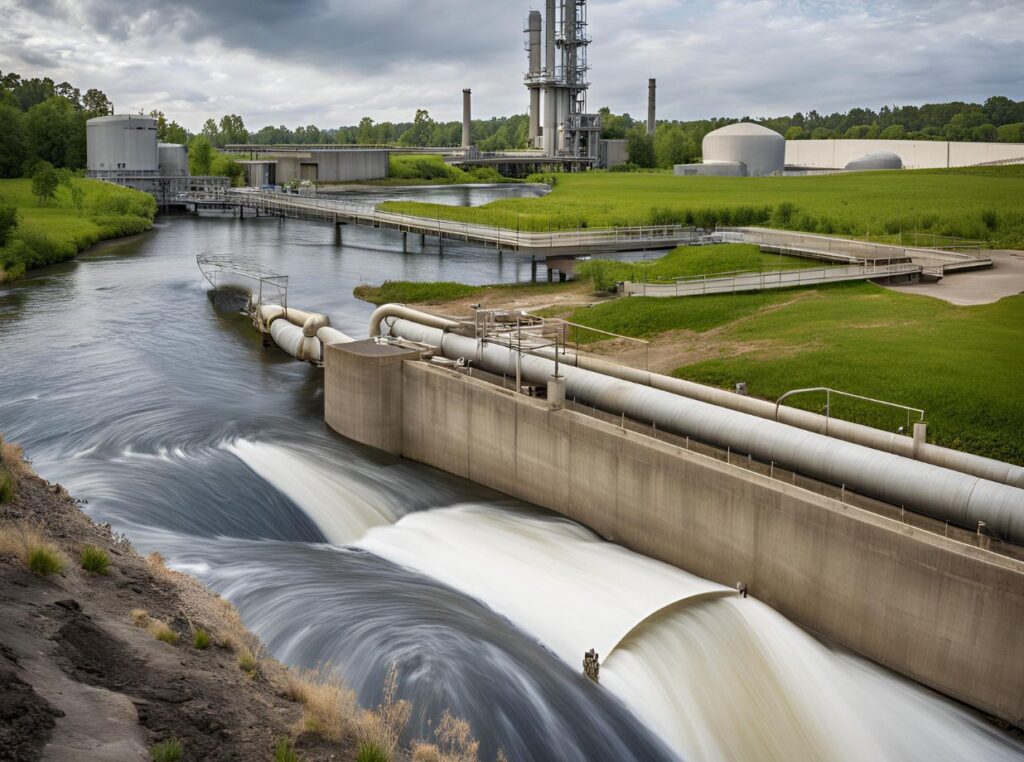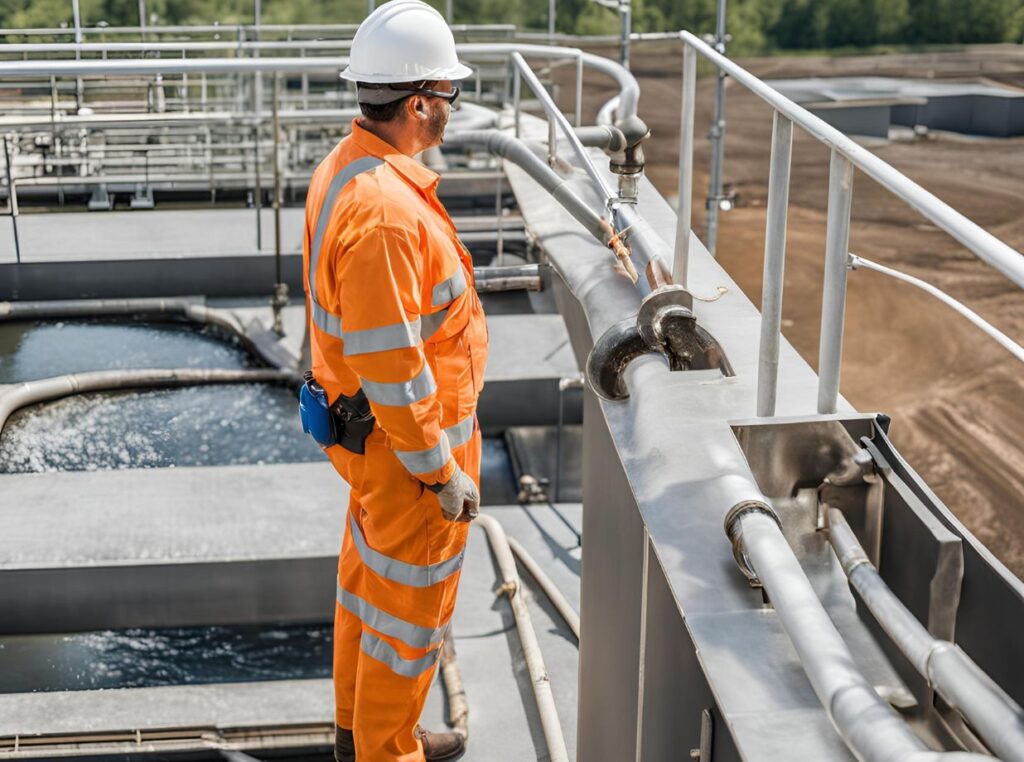In the realm of environmental management, the maintenance of clean water resources is of paramount importance, necessitating efficient wastewater treatment strategies. At the core of these strategies is the role of the wastewater treatment plant operator, whose responsibility centers on the effective removal of pollutants. The National Pollutant Discharge Elimination System (NPDES) permits serve as regulatory guides that stipulate the specific pollutants that operators must manage to adhere to legal standards. This treatise aims to elucidate the complexities of ammonia nitrogen removal—a significant challenge due to its potential aquatic toxicity at minimal concentrations—within the broader framework of wastewater treatment operations.
Your understanding of NPDES permits is fundamental to navigating the intricacies of ammonia nitrogen control. The biological nitrification process, leveraging the capabilities of autotrophic bacteria, is the cornerstone method for the conversion of ammonia to nitrate, thereby mitigating toxicity concerns. Numerous factors, ranging from dissolved oxygen levels to facility design, influence the efficacy of microbial nitrification, necessitating a vigilant approach from operators to ensure compliance. This narrative will further dissect these factors, providing insights into optimal practices and potential system modifications necessary for maintaining the delicate balance required for sustainable wastewater treatment.
Overview of NPDES Permits
Definition and Purpose
The National Pollutant Discharge Elimination System (NPDES) permits are crucial components of the U.S. environmental regulatory framework that ensure the maintenance of water quality. They are designed to control the discharge of pollutants into waters of the United States and are mandated under the Clean Water Act (CWA). The primary purpose of NPDES permits is to preserve water quality by regulating the effluent discharges from point sources, which include municipal and industrial facilities. Through this system, entities are required to obtain a permit before discharging any pollutants, thus limiting the amount of contaminants that can enter rivers, lakes, and oceans.
Historical Background
The NPDES program was established in 1972 with the enactment of the Clean Water Act. Its creation marked a pivotal turn in environmental policy aimed at significantly reducing water pollution. Before the introduction of the NPDES program, pollution levels in many U.S. waterways were alarmingly high, contributing to ecological degradation and posing health risks to humans. The implementation of this program has been vital in reversing these trends by setting stringent limits on the discharge of pollutants, thereby improving the quality of water bodies nationwide.
Importance in Wastewater Treatment
Within the realm of wastewater treatment, NPDES permits serve as a legal and operational guide that wastewater treatment facilities must adhere to in order to lawfully manage their effluent discharges. These permits provide specific guidelines on the types and concentrations of pollutants that can be present in wastewater being returned to the environment. This ensures that treatment facilities operate in a manner that effectively removes harmful substances from wastewater, thereby protecting aquatic ecosystems and public health. The requirements laid out in these permits encourage treatment facilities to enhance their processes and technologies, ultimately leading to better management of water resources.
Legal and Regulatory Framework
Federal Clean Water Act
The Clean Water Act is the cornerstone of surface water quality protection in the United States. This federal law was enacted to restore and maintain the integrity of the nation’s waters by eliminating the discharge of pollutants. By requiring the implementation of NPDES permits, the Clean Water Act laid down a framework for regulating point source pollution control. This legal framework provides the Environmental Protection Agency (EPA) the authority to establish wastewater standards for industry and allow states to assume responsibility for permit issuance under EPA-approved programs.
Role of EPA
The Environmental Protection Agency (EPA) plays a central role in managing the NPDES program. The agency is tasked with the development of policies, guidelines, and standards to ensure clean water is preserved and anthropogenic impacts are minimized. The EPA reviews permit applications, oversees state-level implementations, and provides technical assistance to local authorities to ensure compliance. Additionally, the EPA is responsible for taking enforcement action when violations of the permit conditions are detected, thereby ensuring rigorous adherence to environmental policies designed to protect water quality.
State-Level Implementation
While the EPA provides oversight, most states have been authorized to manage their own NPDES permit programs. State implementation involves issuing permits, ensuring compliance through inspections and monitoring, and enforcing penalties against violators. State-level agencies often tailor permit standards to address specific local environmental conditions, making it possible to account for regional differences in climate, industries, and ecological requirements. This localized approach enables effective management and protection of water resources while aligning with federal standards.
Components of NPDES Permits

Effluent Limitations
Effluent limitations are a key component of NPDES permits, establishing specific caps on the quantity and concentration of pollutants that can be discharged from a facility. These limitations are based on both the technology capabilities of treatment processes and the conditions of the receiving waters to ensure that water quality standards are maintained. The limits are a mechanism to prevent harm to aquatic life, ensure recreational safety, and support public health objectives under the Clean Water Act.
Monitoring and Reporting Requirements
NPDES permits include detailed monitoring and reporting requirements for permit holders to ensure that discharged effluents comply with established limits. Facilities are required to conduct regular testing of their effluent samples for specified pollutants and frequency, maintaining detailed records of their findings. Submitted reports are reviewed by regulatory agencies to verify compliance and detect any anomalies or violations. This rigorous process ensures transparency and accountability, facilitating prompt action if water quality is compromised.
Special Conditions
Special conditions in NPDES permits are additional requirements imposed on particular facilities to address unique circumstances not covered by standard effluent limitations. These conditions might involve the implementation of specific pollutant reduction technologies, conducting impact studies, or undertaking additional monitoring activities. The inclusion of special conditions allows the regulatory framework to adapt to evolving environmental challenges and technological advancements, thereby maintaining the effectiveness of water protection strategies.
Permit Application Process
Pre-Application Consultation
The NPDES permit application process often begins with a pre-application consultation between the applicant and the permitting authority. This step allows the facility to discuss its discharge characteristics, treatment technologies, and potential challenges in meeting permit requirements. Pre-application consultations can facilitate a smoother permitting process by ensuring that applicants understand regulatory expectations and gather relevant information required for the formal application.
Submission Requirements
To apply for an NPDES permit, facilities must submit comprehensive applications detailing the characteristics of their discharge, including sources, volumes, and types of pollutants. Additionally, applicants provide information about the treatment processes in place to manage these effluents, as well as their compliance histories and any previous permit conditions. Documentation of the environmental impact on the receiving waters is often required, ensuring the appropriate precautions are taken to safeguard water quality.
Review and Approval Process
The review and approval process for NPDES permit applications is thorough and involves evaluations from permitting authorities. Submitted applications are assessed for completeness and compliance with regulatory requirements. Public comments may also be solicited to gather stakeholder input on the potential environmental impacts. The final decision to grant or deny a permit takes into account how well applicants meet the established standards and any specific environmental considerations unique to the site.
Compliance and Enforcement
Routine Inspections
Routine inspections are conducted by regulatory agencies to ensure that facilities comply with NPDES permit conditions. Inspections often involve on-site visits to evaluate operations, review monitoring data, and verify treatment effectiveness. Inspectors may also collect independent samples to cross-check the facility’s reported data. The findings from these inspections are used to assess compliance levels and identify any areas needing improvement or rectification.
Violation Consequences
Violations of NPDES permit conditions can result in significant consequences for facilities. Depending on the severity and frequency of non-compliance, regulatory agencies can impose fines, require corrective actions, or revoke permits. Persistent violations might lead to legal action, including court mandates enforcing compliance with environmental standards. These measures are designed to deter violations and ensure that facilities adhere to regulations aimed at protecting water quality.
Strategies for Compliance
To achieve and maintain compliance with NPDES permits, facilities often adopt various strategies, including investing in advanced treatment technologies, enhancing monitoring systems, and implementing staff training programs. Regularly reviewing operational practices and keeping abreast of technological innovations can further assist in meeting permit requirements. Proactive measures, such as identifying potential areas of non-compliance and addressing them before they escalate, are also effective in maintaining adherence to regulatory standards.
Challenges in Ammonia Nitrogen Removal
Sources of Ammonia
Ammonia in wastewater emanates from multiple sources, including domestic, industrial, and recycled internal flows. It is a byproduct of protein degradation, frequently found in household sewage, industrial effluents, and agricultural runoff. Its presence poses challenges in wastewater treatment, necessitating advanced treatment processes to mitigate its harmful effects on aquatic environments.
Environmental Impact
Even at low concentrations, ammonia can be detrimental to aquatic ecosystems, leading to reduced dissolved oxygen levels in water and promoting toxic conditions for fish and other aquatic organisms. Ammonia contributes to nutrient enrichment in water bodies, creating conditions conducive to the proliferation of harmful algal blooms. These blooms can diminish water quality, harm aquatic life, and pose risks to human health through toxins they release.
Monitoring and Assessment
Effective monitoring and assessment of ammonia levels are crucial for maintaining compliance with NPDES permits. Accurate detection of ammonia concentrations allows facilities to adjust treatment processes effectively to meet discharge limits. Implementing advanced sampling and analytical techniques enhances the capacity to monitor ammonia and other nitrogen compounds in real-time, facilitating timely responses to potential non-compliance situations.
Biological Treatment Methods

Nitrification Process
Nitrification is a biological treatment method widely used for the removal of ammonia from wastewater. This process involves the biological oxidation of ammonia to nitrate by autotrophic bacteria, primarily of the genera Nitrosomonas and Nitrobacter. The conversion requires oxygen and occurs in well-aerated environments, making it a critical component of biological wastewater treatment systems designed to control ammonia levels.
Role of Bacteria
Bacteria play an indispensable role in the nitrification process, serving as the biological catalysts that drive the conversion of ammonia into nitrate. These organisms require specific environmental conditions, such as sufficient oxygen, appropriate pH levels, and favorable temperatures, to thrive and function effectively. The presence of a stable and active bacterial population is essential for maintaining the process efficiency and achieving desired ammonia removal outcomes.
System Modifications for Enhanced Performance
To enhance the nitrification process, facilities might need to modify their treatment systems, incorporating advanced aeration technologies or optimizing reactor designs. Adjustments such as increasing the retention time or implementing biofilm carriers can improve the efficiency of nitrifying bacteria, leading to more effective ammonia removal. Continuous evaluation and modification of the system are necessary to adapt to variations in inflow characteristics or regulatory requirements.
Factors Affecting Nitrification
Dissolved Oxygen Levels
Dissolved oxygen levels are crucial to the success of the nitrification process because nitrifying bacteria are strictly aerobic and require adequate oxygen concentrations to function effectively. Insufficient oxygen levels can hinder bacterial activity, leading to incomplete ammonia conversion and increased risk of non-compliance with discharge limits. Therefore, maintaining optimal dissolved oxygen levels is imperative for efficient nitrification.
Temperature and pH
Temperature and pH greatly impact the nitrification process, influencing the activity and growth rates of nitrifying bacteria. High temperatures generally enhance nitrification rates, whereas low temperatures can slow the process or inhibit bacterial function entirely. The pH must be maintained within a suitable range, typically between 6.5 and 8.0, to provide an optimal environment for the bacteria and avoid process disruptions.
Presence of Toxic Compounds
The presence of toxic compounds in wastewater can adversely affect the nitrification process. Substances such as heavy metals or organic toxins can inhibit bacterial activity or even lead to their mortality. Monitoring for these compounds and implementing toxicity reduction strategies are essential steps for ensuring uninterrupted nitrification and maintaining compliance with NPDES permits.
Advanced Treatment Technologies
Denitrification Techniques
Denitrification is a complementary process to nitrification that involves the reduction of nitrate to nitrogen gas, thereby removing it from the wastewater. Techniques for denitrification include the use of anoxic zones within a treatment system, where specific bacteria perform this transformation in the absence of oxygen. Introducing carbon sources can aid in this process by providing the necessary energy and carbon skeletons for the bacteria involved.
Integrating New Technologies
The integration of new technologies, such as membrane bioreactors or advanced biofilm systems, can significantly enhance the capability for both nitrification and denitrification. These technologies offer improved treatment efficiency, footprint reduction, and increased resilience against fluctuations in influent characteristics. The adoption of innovative solutions aids facilities in meeting stringent discharge standards and adapting to evolving regulatory landscapes.
Cost-Effectiveness Analysis
Assessing the cost-effectiveness of treatment technologies is crucial for wastewater facilities planning system upgrades or modifications. Factors such as installation costs, operational expenses, maintenance requirements, and energy consumption need to be evaluated against the expected benefits, such as improved compliance, environmental protection, and potential cost savings from reduced fines or penalties. A comprehensive analysis informs decision-making, ensuring sustainable investments in water treatment infrastructure.
Conclusion
Summary of Key Points
Understanding and adhering to the NPDES permit requirements are essential for maintaining regulatory compliance and protecting water quality. The permits lay out limits, monitoring, and reporting requirements that adhere to federal and state regulations. Facilities face challenges in removing pollutants like ammonia due to its complexity and environmental implications, necessitating the employment of effective biological treatment methods like nitrification.
Future Trends in Wastewater Treatment
Future trends in wastewater treatment are likely to focus on adopting innovative technologies to optimize the efficiency of pollutant removal processes while minimizing environmental footprints. Advances in membrane technology, biological treatment enhancements, and real-time monitoring systems present opportunities for more sustainable and responsive treatment solutions. Facilities will continue to face pressure to upgrade their systems in response to stricter regulatory standards and evolving environmental challenges.
Importance of Ongoing Compliance
The importance of ongoing compliance with NPDES permits cannot be understated, as it is critical to safeguarding water quality and public health. Adhering to permit conditions mitigates environmental impacts, reduces the risk of legal penalties, and supports the sustainable management of water resources. Wastewater treatment facilities must remain vigilant in their operational practices, adapt to regulatory changes, and proactively address potential compliance issues to ensure the continued protection of water environments.
